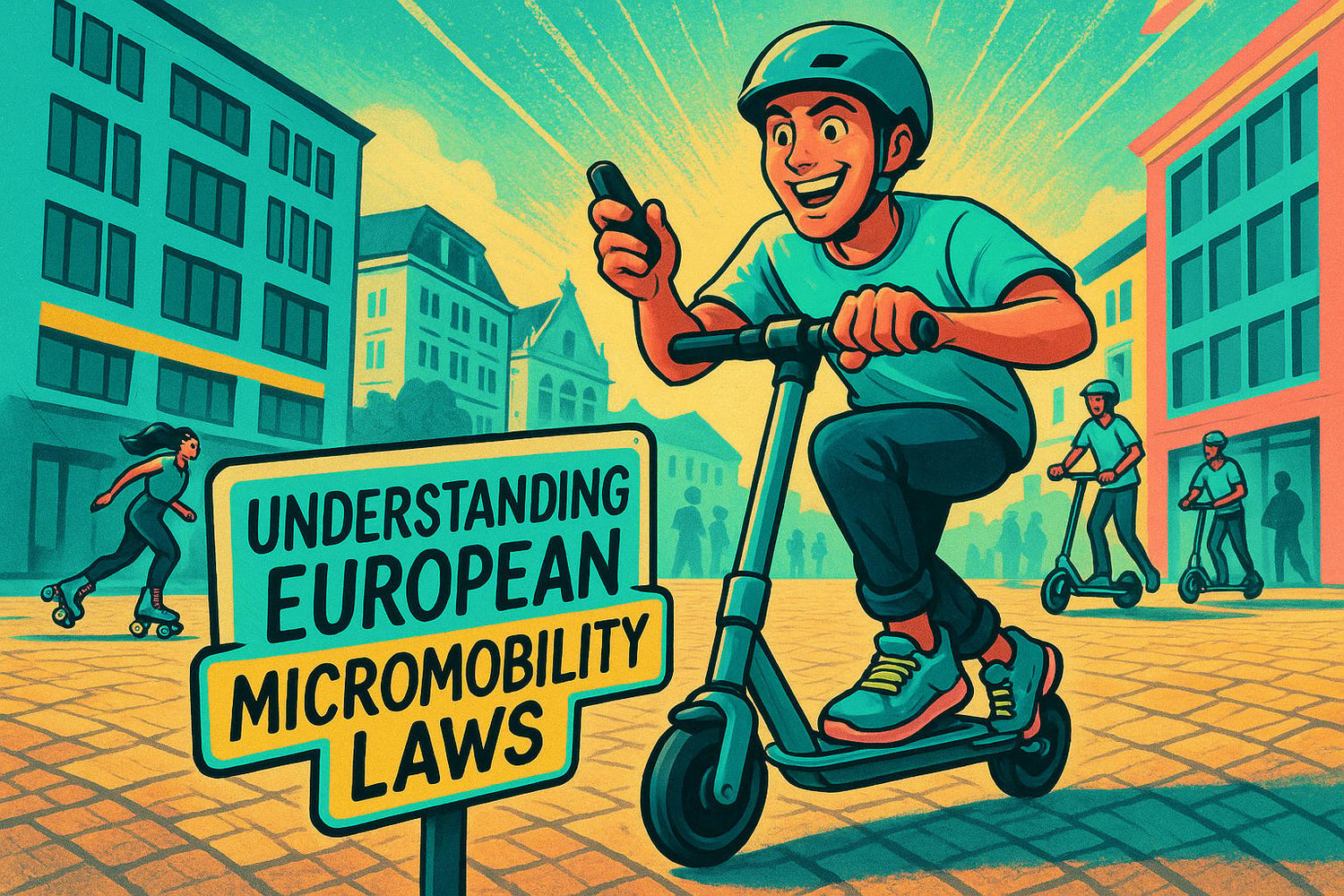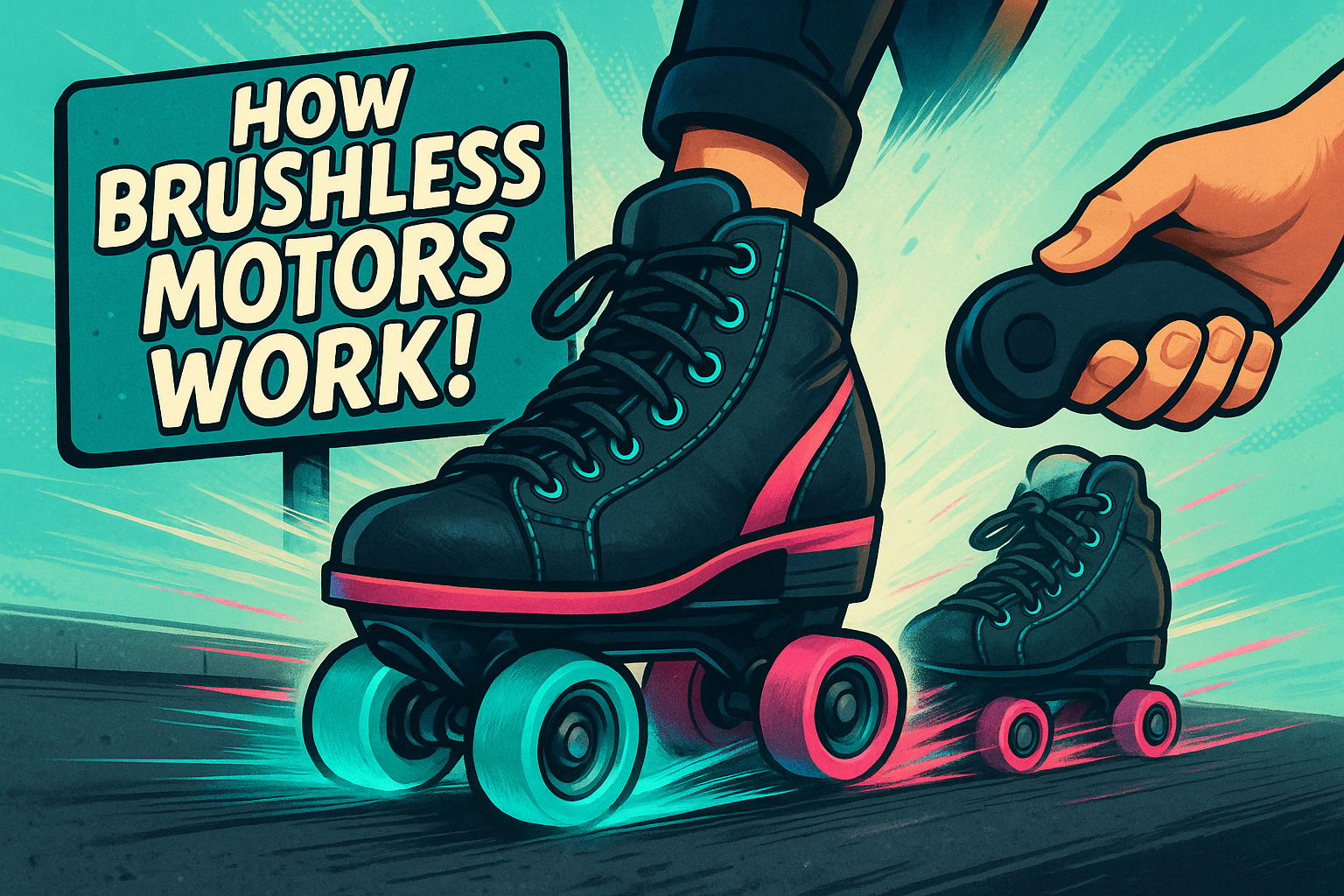Europe's micromobility laws are evolving to regulate electric devices like scooters, hoverboards, and roller skates. These devices offer convenience but come with legal and safety rules. Here's what you need to know:
- Speed and Power Limits: Most countries cap speeds at 12.4–15.5 mph. Power restrictions vary, e.g., Germany allows 500W, while Estonia permits up to 1,000W.
- Insurance Requirements: Devices exceeding 15.5 mph or 55 pounds often require insurance under the 2024 EU Motor Insurance Directive.
- Age Restrictions: Many countries set minimum ages, such as 15 in Finland or 14 in Germany and France.
- Riding Zones: Bike lanes are typically allowed, but sidewalks and pedestrian zones often have strict limits or bans.
- Country-Specific Rules: Each nation has unique regulations. For example, the Netherlands requires RDW approval for scooters, while Italy recently banned e-scooters from sidewalks and urban zones.
Staying informed about local laws ensures compliance, safety, and insurance coverage when using electric devices in Europe.
Electric Scooter Laws in Europe (Numerous Rules You Didn't Know)
Main European Regulations for Electric Devices
European countries are working to establish clear rules for electric personal mobility devices, but the regulatory framework is still evolving. While EU directives provide a general foundation, individual nations adapt these regulations to align with their local needs. Increasingly, these devices are being treated as a separate category, distinct from traditional bicycles and motor vehicles, as governments aim to balance technological progress with public safety.
One major update is the EU Motor Insurance Directive, which came into effect in January 2024. Under this directive, motor vehicle insurance is required for devices that exceed 15.5 mph (25 km/h) or weigh more than 55 pounds (25 kg) when operating at speeds above 8.7 mph (14 km/h). As a result, many users now face mandatory insurance requirements.
In June 2025, Finland updated its micromobility laws, introducing tiered safety regulations and setting a minimum age of 15 for e-scooter use. This reflects a broader European trend of adapting rules to keep pace with emerging transportation technologies.
Basic Rules You Must Follow
General speed limits for electric devices hover around 15.5 mph, but some countries enforce stricter limits, such as 12.4 mph in specific areas. In pedestrian zones, speeds are typically restricted to walking pace. Power limits also vary significantly: Germany caps motor power at 500W, while Estonia allows up to 1,000W. Meanwhile, the Czech Republic limits standard devices to 250W, though retrofitted models can go up to 1,000W.
Age restrictions are becoming more common, with many countries requiring a minimum age for riders. Finland, for instance, has set the bar at 15 years for e-scooter use. In some regions, younger riders may need adult supervision, though the exact rules differ by location.
Insurance is another key requirement under the 2024 EU directive. Devices exceeding specific speed or weight thresholds must now be insured, affecting both user costs and legal responsibilities.
These general guidelines vary widely across Europe, as shown in the country-by-country comparison below.
Country-by-Country Law Comparison
The diverse regulatory landscape in Europe can be challenging for travelers using electric devices. Understanding these differences is crucial for staying compliant when crossing borders. Here's a summary of key rules by country:
| Country | Max Speed | Power Limit | Special Requirements |
|---|---|---|---|
| Germany | 12.4 mph (20 km/h) | 500W | - |
| France | 15.5 mph (25 km/h) | Not specified | 3.7 mph (6 km/h) in pedestrian areas |
| Netherlands | 15.5 mph (25 km/h) | Not specified | RDW approval required for models |
| Italy | 12.4 mph (20 km/h) | Not specified | 3.7 mph (6 km/h) in pedestrian zones |
| Sweden | 12.4 mph (20 km/h) | 250W | Helmet recommended |
| Austria | 15.5 mph (25 km/h) | 600W | Classified as a bicycle |
| Spain | 15.5 mph (25 km/h) | Not specified | City-specific variations |
In Nordic countries, stricter regulations are common. Denmark, Sweden, and Norway enforce a maximum speed of 12.4 mph (20 km/h). Sweden also limits motor power to 250W, making its rules among the toughest in Europe.
In Western Europe, countries like France and the Netherlands generally permit higher speeds but impose specific restrictions. For example, the Netherlands requires RDW approval for certain device models.
Southern Europe takes a mixed approach. Italy enforces a 12.4 mph (20 km/h) speed limit and mandates very low speeds in pedestrian zones, while Spain allows speeds up to 15.5 mph (25 km/h) but lets cities implement their own rules. In Seville, for instance, cycle path speeds are capped at 9.3 mph (15 km/h).
The European Transport Safety Council (ETSC) has called for unified regulations across the EU, suggesting a universal maximum speed of 12.4 mph (20 km/h) for standing devices. Such standardization could simplify the current patchwork of rules.
Devices that exceed national limits may be classified as mopeds or motorcycles, requiring additional licensing, registration, and insurance.
Where You Can and Cannot Ride Electric Devices
Figuring out where you can ride your electric device is just as important as knowing how fast it can go. Across Europe, countries have laid out specific rules about where these devices are allowed and where they’re not. The main idea is simple: protecting pedestrians comes first. So, areas meant primarily for walking often have strict rules or outright bans. However, the details can vary significantly between countries. Let’s take a closer look at where you can legally ride.
Legal Riding Areas
In most countries, bike lanes and cycling paths are the go-to spots for riding electric devices. If those aren’t available, roads with lower speed limits - usually 50 km/h (31 mph) or less - are often acceptable, as long as riders stick to proper road etiquette.
Some countries permit electric devices in pedestrian zones, but only at walking speed (around 6 km/h or 3.7 mph). Others don’t allow them at all. For example, in Belgium, riding in pedestrian zones is only allowed if bicycles are permitted there too.
Sidewalks are generally off-limits, but there are exceptions. In Estonia, riders can use sidewalks if there’s no alternative, but they must give way to pedestrians. In Finland, kids under 12 can ride on sidewalks, but they’re capped at speeds of 15 km/h (9.3 mph).
Italy has taken a stricter stance. Since December 2024, e-scooters are banned from sidewalks, bike lanes, pedestrian areas, and roads outside urban zones. Violators face fines ranging from $54 to $162 (€50 to €150).
"The e‑scooter boom in the EU has been meteoric but each country writes its own playbook. While most nations align on a 25 km/h top speed, others like Germany, Denmark, and Sweden limit it to 20 km/h. Helmet rules vary widely, from mandatory under‑16 in Italy/Spain to fully optional in the Netherlands."
- Leni Doge, Bo Customer Support
Riding Zone Rules by Country
While pedestrian safety remains a shared priority across Europe, the specific rules differ from one country to the next. Here’s a quick comparison of key regulations in several European nations:
| Country | Prohibited Areas | Permitted Areas | Special Notes |
|---|---|---|---|
| Germany | Sidewalks, motorways, pedestrian zones, bus lanes | Bike paths and roads (if no bike path available) | Fines of $16–$33 (€15–€30) for unauthorized riding |
| France | Sidewalks and areas outside urban centers | Cycling paths, streets ≤50 km/h, pedestrian zones (at 6 km/h) | Paris bans parking on pavements |
| Italy | Sidewalks, bike lanes, pedestrian areas, outside urban zones | Limited areas as defined by local rules | New restrictions since December 2024 |
| Belgium | Sidewalks | Bike paths, roads, pedestrian zones (at walking speed if bicycles are allowed) | In Brussels, pedestrian zones cap speeds at 8 km/h (5 mph) |
| Spain | Sidewalks (fines up to $216/€200) | Bike lanes, designated roads | Helmets became mandatory in Barcelona as of February 2025 |
| Estonia | Roads for children under 8 | Cycle tracks, pavements (if no alternatives, with pedestrian priority) | Must leave at least 1.5 m (4.9 ft) of space when parking |
| Denmark | Pavements, footpaths, pedestrian crossings | Bike lanes only | Regulations are particularly strict |
| Finland | Pavements (except for children under 12) | Cycle paths, roads, dirt tracks | Kids under 12 can use sidewalks at speeds up to 15 km/h (9.3 mph) |
Some cities take these rules even further. In Brussels, parking violations for electric devices can result in fines of $54 (€50). Riders are also prohibited from parking on pavements, cycle paths, near crosswalks, or close to public transport stops. In Oslo, Norway, e-scooter rentals are banned from 11:00 PM to 5:00 AM, and parking violations come with an $83 (NOK 900) fine.
In September 2023, Paris made headlines when 90% of voters supported banning rental e-scooters from public streets. Privately owned devices are still allowed, but the decision was driven by concerns over blocked sidewalks, drunk riding, and careless usage.
Across Europe, alcohol restrictions for electric device riders are strictly enforced, with blood alcohol limits often matching those for drivers. Carrying passengers is almost always prohibited, and cities are cracking down on improper parking to keep pedestrian areas clear.
Knowing these country-specific rules is key to staying on the right side of the law when using electric scooters or other personal mobility devices in Europe.
sbb-itb-bf837b9
Detailed Laws and Tips for Major European Countries
Each European country has its own set of rules when it comes to age limits, approvals, and insurance requirements for electric devices. These variations underscore the differences in how regulations are applied across the continent.
Germany: Age Limits and Strict Compliance
In Germany, riders must be at least 14 years old. While no license is required, electric devices must have a General Operating Permit (ABE). Additionally, they need to display an insurance sticker as proof of mandatory liability coverage.
France: Insurance Without Extra Hassle
France also sets the minimum riding age at 14, with no license needed. However, third-party insurance is compulsory. Unlike Germany, there’s no requirement for additional vehicle approval or registration, making it relatively straightforward to comply with the rules.
The Netherlands: High Standards for Safety
The Netherlands takes a slightly different approach. Riders must be at least 16 years old, and road-approved electric scooters need RDW approval (the Dutch vehicle authority). They must also display a license plate and carry third-party insurance.
For legal and safe use in the Netherlands, it’s crucial to ensure your device meets RDW standards and is properly insured. Authorities place a strong emphasis on safety and maintaining high-quality vehicle standards, so following these guidelines is non-negotiable if you want to ride legally.
How Wheelfeet Electric Roller Skates Meet European Laws

Wheelfeet’s electric roller skates are crafted with thoughtful engineering to align with European regulations while maintaining excellent functionality. Their design prioritizes both legal compliance and user experience.
Features Designed for Compliance and Safety
- Adjustable Speed: Equipped with a wireless remote, the skates are capped at a top speed of 15 mph (25 km/h), adhering to local speed limits.
- Regenerative Braking: This system ensures smooth and reliable stops while also recycling energy to extend the range to 9 miles (15 km).
- Lightweight Frame: Built with a sturdy aluminum frame, the skates are easy to carry without compromising durability.
- Dual-Mode Functionality: Riders can seamlessly switch between electric power and manual skating, making them adaptable for various settings.
These features not only keep the skates within legal boundaries but also prioritize the rider's safety and convenience.
Following European Electric Device Laws
Keeping up with European micromobility regulations isn't just about avoiding fines - it’s about ensuring safety for yourself and others. These rules are in place to create a safer environment for everyone using electric personal transportation devices.
The regulatory framework for these devices is constantly shifting. From EU-wide directives to national laws and local municipal rules, the legal landscape is evolving rapidly [13-16]. What’s allowed in your city today could face new restrictions tomorrow, making it essential to stay informed.
To stay updated, regularly check official government portals and city websites, as transport authorities often release new rules and enforcement guidelines [13-16]. These sources are invaluable for understanding the latest developments.
Additionally, industry associations and online platforms that focus on micromobility policies across Europe can provide useful insights. They often highlight upcoming policy changes and offer detailed overviews of current regulations. Making these resources part of your routine can help you stay ahead of the curve.
Before heading out on a ride, take a moment to ensure you’re following local rules. Check that your device’s speed settings comply with limits, wear any required safety gear, and confirm you’re riding in designated areas. This small effort not only keeps you safe but also shows a commitment to being a responsible member of your community.
FAQs
How do micromobility laws differ across European countries?
Micromobility regulations across Europe can differ significantly, especially for devices like electric scooters and roller skates. These differences often revolve around speed limits, minimum age requirements, and approved usage areas. Take Belgium, for instance: electric scooters are permitted on public roads as long as they don’t exceed 15.5 mph (25 km/h), and riders must be at least 14 years old. While helmets are advised, they’re not mandatory. In Germany, the rules are stricter - e-scooters are capped at 12.4 mph (20 km/h), and riding on sidewalks is completely off-limits, with penalties in place for those who break the law.
Although the EU is aiming to harmonize these rules, for now, each country sets its own standards regarding safety gear, speed restrictions, and designated riding zones. If you’re planning to use micromobility devices while traveling, it’s essential to check the local laws to stay compliant and steer clear of fines.
What does the 2024 EU Motor Insurance Directive mean for e-scooter and other electric device users?
The 2024 EU Motor Insurance Directive brings a new requirement: mandatory liability insurance for specific electric personal transportation devices, such as e-scooters. If your device weighs over 55 lbs or can go faster than 15.5 mph, you’ll need insurance to cover any damages or injuries that might occur while using it.
This policy aims to improve road safety and provide legal protection for users. Make sure to review your country's specific regulations to remain compliant and steer clear of potential penalties.
How can I make sure my electric transportation device follows local laws while traveling in Europe?
To make sure your electric transportation device aligns with local laws in Europe, start by reviewing its technical specifications. Many countries set speed limits for these devices, usually around 12–15 mph (20–25 km/h), and require essential safety features like brakes, lights, and reflectors. Some regions may also restrict where you can ride, such as prohibiting use on sidewalks or in pedestrian zones.
It's also important to research the specific regulations of each country you'll visit. These might include age limits, mandatory helmets, or even insurance requirements. If you're traveling by air, double-check that your device's battery complies with international travel regulations. Being informed and prepared will make it easier to enjoy the convenience of electric transport while exploring Europe's streets.




Leave a comment
All comments are moderated before being published.
This site is protected by hCaptcha and the hCaptcha Privacy Policy and Terms of Service apply.